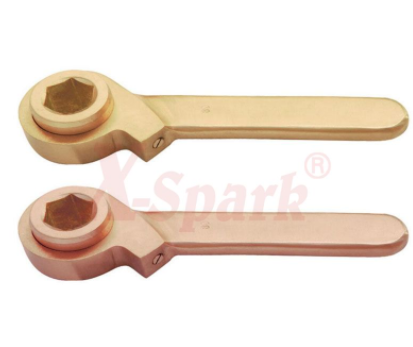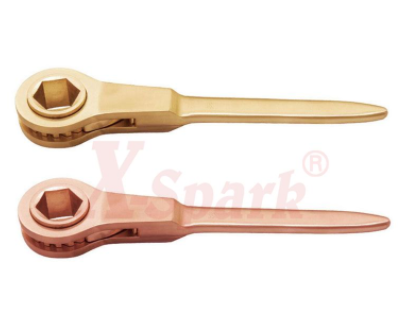What kinds of wrenches are there?
Wrenches are made in various shapes and sizes and are used for gripping, fastening, turning, tightening and loosening things like pipes, pipe fittings, nuts and bolts. There are basically two major kinds of wrenches:
Pipe wrenches used in plumbing for gripping round (cylindrical) things.
General use wrenches used on nuts and bolts that have flat, parallel surfaces; e.g., square or hexagonal (hex).
Wrenches may be adjustable to fit different sized pipes, nuts and bolts or may be a fixed size.
What are some examples of fixed-size wrenches?
Fixed-sized wrenches include:
Open ended wrenches that have "jaws" with parallel sides or tines that fit snugly on nuts and bolts.
Closed end or box wrenches that have a loop at the end with notches on the inside that allow the wrench to fit either square or hex nuts or both (depending on the number of notches or points).
Combination wrenches that have both an open end and a closed end on either end of the wrench; usually they fit the same size nut or bolt.
Socket wrenches are similar to closed end wrenches except they are cylindrical in shape. They can fit over a nut in a recessed hole that would be inaccessible with open or closed ended wrenches. These wrenches have an offset handle at right angles to the nut being tightened or loosened. Usually the handle is a ratchet-type handle that allows the user to turn the socket continuously in one direction by moving the handle back and forth without having to take the socket off the nut.
Torque wrenches, one type of socket wrenches, have a built-in spring-loaded indicator that shows how much torque being is being applied (i.e., shows how hard the nut is being tightened).
Nut drivers, another type of socket wrenches, are sockets that can be snapped on or permanently fixed to a screwdriver-type handle.
Allen wrenches or Allen keys are hexagon-shaped (six-sided) metal shafts that are bent into an L-shape for leverage. Hex drivers are "straight Allen wrenches" that have a screwdriver-type handle. These are different from the other wrenches since they fit inside a recessed hexagonal hole in screw heads instead of around a nut or bolt.
Fixed wrenches fit single, specific sizes. Metric wrench sizes are expressed as whole numbers (e.g., 8, 10, 14, 32) that correspond to the sizes in millimetres. Non-metric sizes used widely in the U.S. are also called S.A.E (Society of Automotive Engineers) sizes and are expressed as fractions of an inch; e.g., 1/4, 1/2, 3/4, 1 1/4. Since both metric and S.A.E. fasteners (nuts, bolts, etc.) are used in Canada, users must select the correct type and size of wrench to prevent injuries and damage to equipment in case of slippage when force is applied to the wrench.
What are general safety tips when using wrenches?
Use the correct wrench for the job - pipe wrenches for pipes plumbing fittings, and general use wrenches for nuts and bolts.
Discard any damaged wrenches (e.g., open-ended wrenches with spread jaws or box wrenched with broken or damaged points).
Select the correct jaw size to avoid slippage.
Wear safety glasses or a face shield (with safety glasses or goggles) where there is a hazard of flying particles or falling debris.
Position your body in a way that will prevent you from losing balance and hurting yourself if the wrench slips or something (e.g., a bolt) suddenly breaks.
Use a box or socket wrench with a straight handle, rather than an offset handle, when possible.
Ensure that the jaw of an open ended wrench is in full contact (fully seated, "flat", not tilted) with the nut or bolt before applying pressure.
When turning with an adjustable wrench, the direction of the turn should be against (towards) the permanent jaw.
Ensure that the teeth of a pipe wrench are sharp and free of oil and debris and that the pipe or fitting is clean to prevent unexpected slippage and possible injuries.
Apply a small amount of pressure to a ratchet wrench initially to ensure that the ratchet wheel (or gear) is engaged with the pawl (a catch fitting in the gear) for the direction you are applying pressure.
Support the head of the ratchet wrench when socket extensions are used.
Pull on a wrench using a slow, steady pull; do not use fast, jerky movements.
Stand aside when work is done with wrenches overhead.
Make sure adjustable wrenches do not "slide" open during use.
Keep tools well maintained (cleaned and oiled).
Clean and place tools and wrenches in a tool box, rack or tool belt after use.
What are the hazards of using wrenches?
Hazards may vary depending on the work and can include:
The wrench slips off of the work,
The work piece may suddenly break free causing you to lose balance,
The wrench or work piece may break, or
Turning the handle quickly or with pressure may create stress and strains on the hand or arm.
What should I avoid doing when using wrenches?
Do not use push on a wrench - losing your balance is more likely if the wrench slips.
Do not use a wrench that is bent handle or damaged.
Do not use worn adjustable wrenches. Inspect the knurl, jaw, and pin for wear.
Do not pull on an adjustable wrench that is loosely adjusted.
Do not use pipe wrenches on nuts or bolts.
Do not use pipe wrenches for lifting or bending pipes.
Do not use a wrench on moving machinery.
Do not use the wrong tools for the job. Never use pliers instead of a wrench or a wrench as a hammer.
Do not use a make-shift wrench.
Do not insert a shim in a wrench for a better fit.
Do not strike a wrench (except a "strike face" wrench) with a hammer, or similar object, to gain more force.
Do not increase the leverage by adding sleeved additions (e.g., a pipe) to increase tool handle length.
Do not expose a wrench to excessive heat (like from a blow torch) that could affect the temper of the metal and ruin the tool.
Contact Hebei Botou Safety Tools Group for more tips.


评论
发表评论